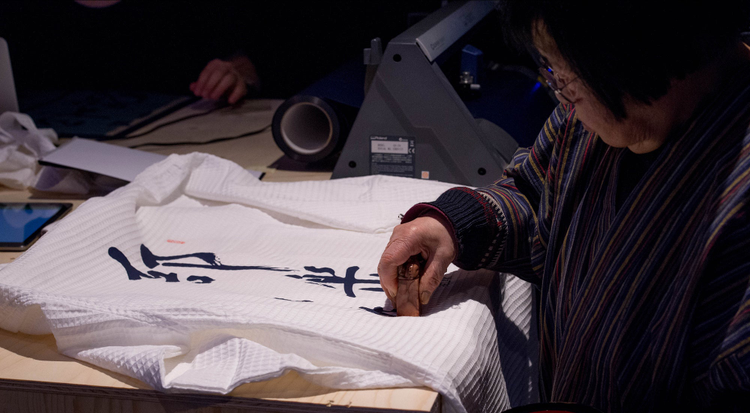For me painting calligraphy is a testimony, a proof that I am living right now, in the moment. Doing calligraphy in Japan is a part of being a human being. You learn how it should be done, but at the same time it is also a mental and physiological training.
At our recent Adobe Digital Experience Briefing in Stockholm we not only hosted many inspiring speakers who talked about the importance of embracing digital transformation (you may watch the keynotes from the event here), we also had some popular activities in the breaks between the keynotes.
The most popular activity was probably artist Hiroko Kimura creating the attendee names in Shodo (Japanese calligraphy). Via the Adobe Capture CC app we transferred her calligraphic expression of the attendee names to Illustrator CC and printed them on kimonos for the audience to take home. To finalise the calligraphy she used rakkan, some special Japanese stamps for calligraphy, this makes the calligraphy vivid and completely in balance. The stamping of the rakkan directly on the kimono was the basis for this project in order to protect the original art, and the proof of it is unique calligraphy made by Hiroko Kimura.
Having Hiroko Kimura at our Digital Experience Briefing showcases what we at Adobe aim to achieve with our creative solutions, namely taking the creative workflow to the next level – in this case turning ancient Japanese art into a digital experience, all in a fun and simple way.
Shodo as a part of being human
Despite being 81 years old, Hiroko Kimura is still an active artist working in Sweden.
She knows every detail about the Japanese language and is a “living Japanese dictionary”: Hiroko Kimura can draw over 300,000 Japanese characters from her memory.
Hiroko Kimura is internationally acclaimed as a watercolour and oil painting artist – she has even been recognised with a cultural award from the Japanese Government. Hiroko Kimura is writing Japanese language in her own artistic way, because far Eastern calligraphy is an art within art, a way of life, and, is said to be a path to immortality. Just like love fills the heart, calligraphy is said to fill our souls, nourishing a new sense of life born out of selflessness, absence of pride in the fertile soil of a pure mind:
“For me painting calligraphy is a testimony, a proof that I am living right now, in the moment. Doing calligraphy in Japan is a part of being a human being. You learn how it should be done, but at the same time it is also a mental and physiological training. It can be compared to when you are creating a new font: you are also striving to do the ultimate calligraphy in your style,” explains Hiroko Kimura.
Digitisation is funny
Hiroko came to Sweden in 1978 to teach Shodo at Skånes Konstakademi, she later moved to Stockholm where she gives classes at the University of Stockholm.
Her taking part at Adobe Digital Experience Briefing in Stockholm marks the first time ever that her works have been digitised.
“The digitisation of my works is very funny. The expression of my calligraphy came out in high quality so it was done very nicely as an art on the texture of the kiminos,” says Hiroko Kimura. We’re pretty sure our event attendees will agree – and hopefully they will wear their printed kimonos often.
